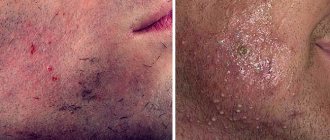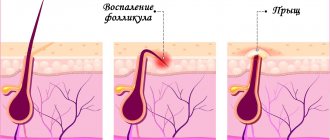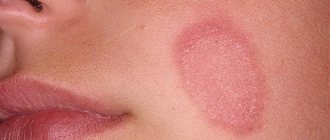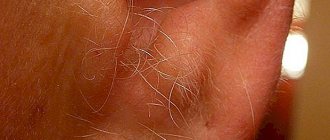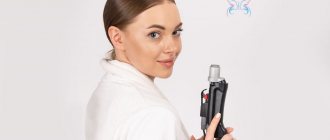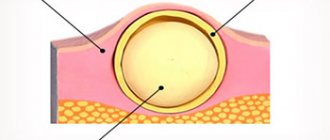Most girls prefer to use a razor to remove unwanted hair from the body; this method helps to get rid of it for only 2-3 days, after which you have to repeat the manipulations. In fact, hair removal at home can now be carried out using different techniques, which imply not only effective, but also safe hair removal.
Hair removal methods
You can do hair removal at home yourself in almost any area: on the legs, arms, armpits, stomach or bikini area. The only place where you can’t do without an assistant is the back, although girls rarely wax it.
There are two main methods of hair removal:
- Full. This type of hair removal at home involves removing unwanted hair and hair follicles. This increases the long-term preservation of the result, since the root system is restored within 2.5-3 weeks, which is why the effect of smooth skin can last up to a month.
- Partial. The method involves removing only part of the hair that protrudes on the surface of the epidermis, while the root system remains intact. Because of this, the skin ceases to be smooth after 1-2 days.
Epilation at home is most often performed partially. This is due to the fact that it is sometimes safer and takes only 5-15 minutes, after which the girl can enjoy absolutely smooth skin on her body.
But if we talk about the effectiveness of partial removal, it loses significantly, since the result after it lasts 10-15 times less than after total depilation.
Which method is most effective?
A cosmetologist can determine which type of hair removal is most effective. The result of any method depends on the selection of the necessary parameters for performing the procedure and on the experience of the specialist. It is important not to violate the regime and intervals between procedures, especially hardware ones.
Let us remind you that the goal of each type of hair removal is to destroy the hair follicle, and this is not always possible in one session. Not all hair that a person has can be removed permanently. 30% of all hair follicles are in reserve and can grow even after a full course, so be patient and achieve perfect skin! All the time and effort (and even money) spent can pay off handsomely with persistence and patience.
Depilation methods
Depilation is a procedure that involves removing hairs along with the root system. It doesn't matter what technique the woman uses.
If we talk about salon methods of hair removal, we cannot fail to mention laser, electric and photoepilation. The methods have different degrees and types of effects on the root system, but they all help neutralize melanin and keratin, which inhibits hair growth for a long period - from 1 year to 6 years.
However, there are other methods of depilation that can be performed at home:
- Waxing;
- Honey depilation;
- Sugaring;
- Epilator.
All methods allow you to eliminate unwanted hairs for 2-4 weeks, since they are removed along with the hair follicles.
How to make the right choice of hair removal method?
In order to choose the optimal type of hair removal for yourself, you must follow these rules:
- Before making your final choice, you should first consult with a dermatologist. He will examine the condition of your skin and hair. After a visual inspection, a specialist will be able to determine in advance the type of laser used and the procedure that suits you.
- Also, consult a specialist or find out the contraindications yourself. Laser hair removal is not suitable for everyone; it has a certain number of disadvantages and limitations that you need to be aware of.
- Laser hair removal is contraindicated for people who have metal prostheses, crowns, plates and pacemakers in their bodies. The laser will affect them too. It is also necessary to first find out whether there is a possibility of allergic reactions to the gels and cosmetics used during and after hair removal.
Many patients make a choice by eliminating those methods that are simply not suitable for the characteristics of the body or skin type. This makes it much easier to choose the method that will be optimal for you. An indispensable condition is a preliminary consultation with a dermatologist and hair removal specialist.
Other hair removal methods
Before you do hair removal at home, pay attention to all the technologies that you can use yourself.
In addition to shaving, partial methods for removing unwanted hair include the use of special depilatory creams. They are applied to the surface of the skin, and then within 10-15 minutes they completely corrode the hairs, facilitating their separation from the base. The separated hairs are removed with a special spatula.
If we talk about removing facial hair, many girls use regular tweezers for this sensitive area. Even though it removes hairs from the roots, careless use of the tool can lead to hair breakage, causing blackheads or even ingrown hairs to appear on the skin.
Hair removal with an epilator
One of the ways to completely remove hairs is to tear them out with an epilator. The device is a small mechanical machine that fits comfortably in your hand and uses a roller attachment to gradually grab and pull out hairs.
There are two types of epilators:
- Disk. The attachment of disk epilators contains 10-12 pairs of disks located close to each other. Hairs, falling between the discs, are captured and scrolled by them, which leads to their tearing out.
- Tweezers. Instead of discs, the roller attachment contains small tweezers (from 10 to 20 pieces), which quickly and effectively pull out hairs without breaking them.
An epilator is a rather painful device, especially when using it for the first time. However, with regular use of the device, the girl’s pain threshold increases, which is why the discomfort during hair removal is not felt so much.
The main advantage of the epilator is its versatility. It equally effectively removes both soft and coarse and dense hair, making this procedure suitable for everyone.
Sugaring
Sugar depilation, otherwise called “Sugaring,” involves the use of a special sugar-based paste. You can even prepare it yourself, so this method is often used at home.
The high stickiness of the paste, when applied to the skin, promotes its tight adhesion to the hairs. It envelops them and pulls them out when the paste is sharply torn off from the epidermis. When the technology is performed correctly, it does not cause discomfort to the girl, but on the contrary, it resembles a light massage.
Sugaring pastes
Before doing hair removal at home, pay attention to the choice of sugar paste. The effectiveness of manipulations, as well as safety for the skin, will depend on its quality.
As a standard, sugaring paste is divided into three types depending on its density:
- Dense. Removes thick and coarse hairs. Most often used for depilation of the bikini area.
- Medium density. Removes medium-thick hairs. Used to remove hair in armpits and legs.
- Liquid. It has a more gentle effect, removing hair from the hands and face.
If we talk about specific brands, pay attention to the following manufacturers:
- MARIS;
- Gloria;
- OASIS;
- Start Epil.
Before doing hair removal with sugar paste, it is not necessary to buy special professional compounds that are used in salons. For the homemade procedure, you can prepare the pasta yourself, the main thing is to observe all the proportions and cooking time.
Sugaring technique
Sugaring begins, like any depilation, with preparing the skin - steaming, treating with a disinfectant solution, sprinkling with talcum powder or baby powder.
Then a little sugar paste is applied to the skin, without lifting the spatula, it is distributed and sharply torn off. When performing sugaring yourself, you need to do everything smoothly but quickly. Do not level the sticky layer for too long to prevent the formation of a “stick”, which can only be removed with a paper bandage.
Cream that slows hair growth
Cosmetics that can slow down hair growth contain Topical eflornithine. . It prevents the formation of a substance that stimulates the growth of the hair follicle. After about 6 to 8 weeks of regular use of eflornithine cream, the number of hairs and their thickness may decrease significantly.
The final effect depends on the type of hair in the areas where the cream was used.
If the hairs were relatively thin or light, the cream can create the visual effect of complete hair removal. If the hairs were dark and thick, the cream could be a good addition to another hair removal method. Hair becomes thinner and sparser, so the risk of irritation and ingrown hairs after mechanical hair removal is significantly reduced.
The main disadvantage of creams to slow down hair growth is the need for frequent and regular use. About 8 weeks after stopping use of eflornithine, hair begins to grow back as before.
Honey hair removal
The technique is similar to sugaring, however, based on the name, it uses a honey-based paste. The technique and features of the procedure are the same as for sugar depilation, but the honey base is more gentle on the skin.
Honey paste does not have such strong adhesion to the skin, which is why it is not suitable for treating the bikini area, which is due to the coarse hairs in this area.
In addition, irritation after honey hair removal occurs much less frequently than after sugaring. However, keep in mind that side effects cannot be avoided if you are allergic to honey.
Melanin is a determining factor in effectiveness
It is this pigment that is responsible for the shade of hair. The higher its content in the structure of vegetation, the easier it is to “warm it up” with the energy of the generated beam. A laser is a beam of light that penetrates the deep layers of the epidermis with lightning speed and affects the follicle. The hair shaft containing melanin quickly absorbs heat and is destroyed. Dark hair contains a lot of rich pigment. Therefore, they warm up well, guaranteed.
Some difficulties arise when performing laser hair removal of light hair on the face. Light, gray hair lacks melanin. The pigment may be present in small quantities. The result is that the laser simply does not “see” the hair, and its energy is not able to be absorbed by the growth. Colorless hair simply reflects more rays. Features of the interaction between laser and hair shade:
- Light, red, thinning vegetation - there is little pigment, there is no way to warm it up, the follicle is poorly destroyed.
- Gray hair means there is no melanin.
- Discolored or colored growths - laser hair removal should not be performed on blondes who have artificially changed their color. This is a useless procedure due to the fact that the melanin has been completely replaced by artificial pigments of chemical compositions.
But even with laser hair removal for blonde hair, you can count on the effect if you choose the right technique.
Waxing
Wax depilation involves the use of special cosmetic wax, which is absolutely safe for a girl’s skin and is effective in combating unwanted hair in any area.
There are three types of waxing: hot, warm and cold. The methods differ not only in the types of wax used, but also in the effectiveness of the procedure.
Epilation with hot wax
The most common technique that equally effectively removes both hard hairs in the bikini area and the softest ones - above the upper lip.
For hot depilation, hard wax in granules is used, which is first melted at a temperature of 60 degrees to a homogeneous semi-liquid consistency, and then distributed over the skin in a thin layer. Upon contact with the epidermis for 15 seconds, the wax hardens and then comes off as a single sheet along with the hairs.
The main disadvantage of the procedure is the risk of getting a thermal burn when the wax overheats. To avoid this, it is recommended to buy a wax melter, which will heat the base to a comfortable temperature and maintain it.
Hair removal with warm wax
Warm wax initially has a fairly dense consistency, which must first be melted. To do this, the base is heated in a microwave oven to a temperature of 50 degrees.
The wax is applied to the girl's skin, and a fabric or paper bandage is fixed on top of it, carefully smoothed to the sticky layer. The bandage is abruptly torn off the skin along with wax and unwanted hair.
The technique is less effective in dealing with coarse hairs, but is also safer.
Cold wax epilation
Cold waxing is a hair removal technology using wax strips, sold in any cosmetic store.
The strips are rubbed between the palms and then firmly fixed on the skin. After sharply tearing off the strips, the treated area remains smooth, but then slight irritation may appear on it.
The strips contain a fairly thin layer of wax, making them suitable for removing soft and fine hairs. It is most effective to use them in the armpits and above the upper lip.
What to remember
Compare the advantages and disadvantages of all methods and choose the one that suits you.
| Method | Effect duration | Advantages | Flaws |
| Mechanical hair removal (waxing, sugaring, electric epilator) | 1–3 weeks | Low price, can be done at home | Painful, short-lived effect, ingrown hair under the skin. Hair must grow to a certain length before using this method. |
| Cream that slows hair growth | While the cream is being used | Can be done at home | Not good for thick hair |
| Electrolysis | Permanent effect, but requires several sessions to achieve it | Suitable for all skin types, removes any hair | Painful and expensive procedure, one session takes a long time, hyperpigmentation and scarring are possible |
| Photoepilation | 1–3 months with a decrease in hair thickness and density with repeated sessions | The session does not last long and is not as painful as electrolysis | Cannot be used by people with dark or tanned skin; sessions must be repeated periodically; it is more expensive than electrolysis; in rare cases, side effects are possible |
Photoepilation and laser hair removal
In many ways, these procedures, which allow you to permanently remove hair, are similar to each other, but still, you need to consider each of them separately. To perform laser hair removal, a high-precision laser beam is used, which affects the hair follicle during the period of active hair growth, since at this time it is maximally enriched with melanin. There are no more than 30% of actively growing hairs in a particular area of the human body, so you should not believe advertising in which the client is promised complete hair removal in one session. The full course ranges from 5 to 10 sessions. You need to be prepared for the fact that you will have to visit the salon monthly. After completing a full course of hair removal, you can get rid of hair forever, although corrections will need to be made 1-2 times a year.
Laser hair removal requires preparation:
- 2 weeks before the procedure, you should stop taking anti-inflammatory and antibacterial drugs of the tetracycline group, as well as antipsychotics and antidepressants.
- For 2 weeks, stop going to the solarium and sunbathing. It is for this reason that cosmetologists advise doing hair removal during the cold season.
- 3 weeks before the procedure, alcohol-containing lotions, creams, etc. should not be applied to the skin from which hair will be removed.
- It is not recommended to take a hot shower or bath 1 day before the procedure.
Lasers used for hair removal:
- diode;
- alexandrite;
- ruby.
When performing laser hair removal, the length of unwanted hair should exceed 3 millimeters, and several months before the procedure, you should abandon any other hair removal methods other than shaving. The duration of 1 hair removal session and the number of laser flashes depends on the size of the treated area and the density of the hairs on it. For example, removing whiskers from women will take only 10 minutes, while deep bikini hair removal will take about 1 hour. Whatever laser equipment is used, the client's eyes must be protected with special glasses. Laser hair removal causes minor discomfort, which can be tolerated, but if the patient has a low pain threshold, the specialist can apply an anesthetic cream to the skin.
After epilation, a cream is applied to the skin to eliminate irritation. At home, the client is recommended to use a nourishing cream or lotion. If there are blisters on the skin after the procedure (although this is a rare occurrence), Bepanten or Panthenol can be applied to the affected areas. To avoid complications after hair removal, you need to follow these rules:
- Do not sunbathe or visit the steam room (swimming pool, beach).
- Avoid taking tetracycline antibiotics, antipsychotics, anti-inflammatory drugs, and antidepressants.
- Do not pick off scabs from burn wounds.
- Do not rub the area from which hair has been removed with a washcloth.
- Do not apply lotions or cosmetic oils containing alcohol.
Contraindications to laser hair removal:
- Dermatological diseases.
- Hypertension and coronary heart disease.
- The presence of orthopedic prostheses, an intrauterine device and a pacemaker.
- Diabetes.
- Oncological diseases.
- Pregnancy and breastfeeding.
- Lack of a formed menstrual cycle (if the intimate area is epilated).
Photoepilation is not inferior to laser hair removal. To carry it out, modern krypton lamps are used, the functioning of which resembles a camera flash. The radiation range of cosmetic lamps ranges from ultraviolet to infrared radiation.
Before using hair removal equipment, you should adjust the narrow spectrum of radiation, which would destroy melanin, but at the same time be safe for the skin. That is why krypton lamps are equipped with filters that prevent ultraviolet radiation from affecting the skin. But no filter compresses the spectrum of light waves, so they heat not only the hair, but also the skin around it. This phenomenon is not typical for laser hair removal. According to most dermatologists, it is considered safer for the skin compared to photoepilation.
Judging by the reviews of people who have used photoepilation, the sessions are accompanied by minor discomfort. As for the result from photoepilation, it is similar to that achieved with laser hair removal. The duration of photoepilation will be shorter when compared with laser hair removal, since the krypton lamp emits diffused light, allowing it to treat a larger area of skin.
As for preparation for the procedure, as well as skin care and contraindications, they are similar to laser hair removal. It is worth noting that photo and laser flashes lead to rapid loss of moisture in the body, so in the first days after laser and photo hair removal you need to drink more water.
